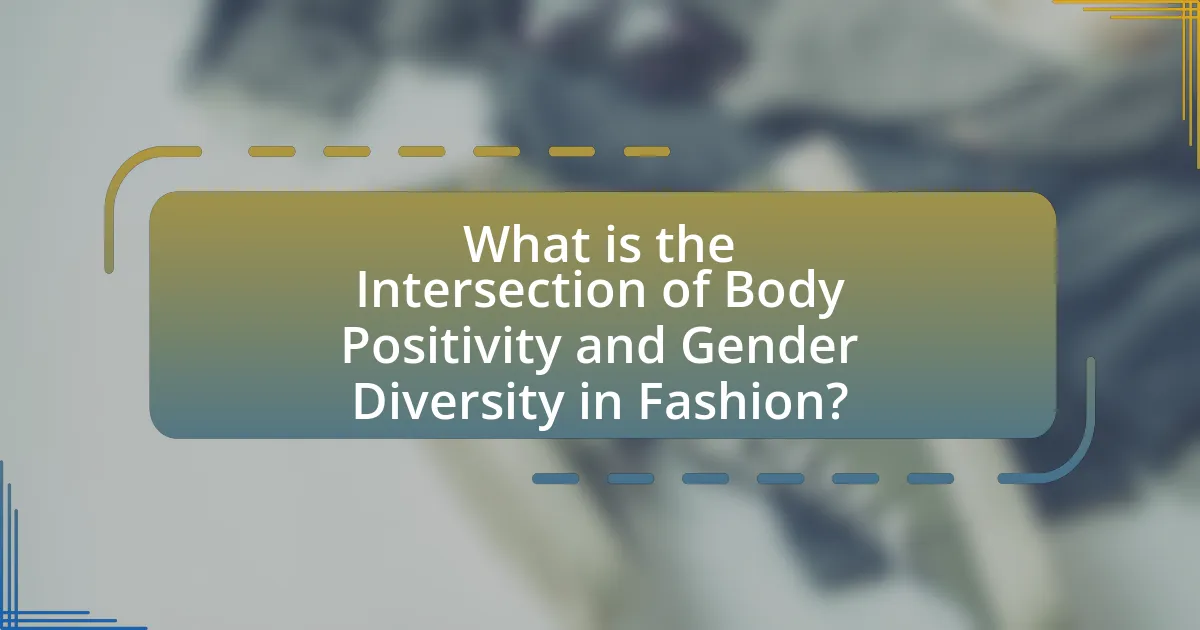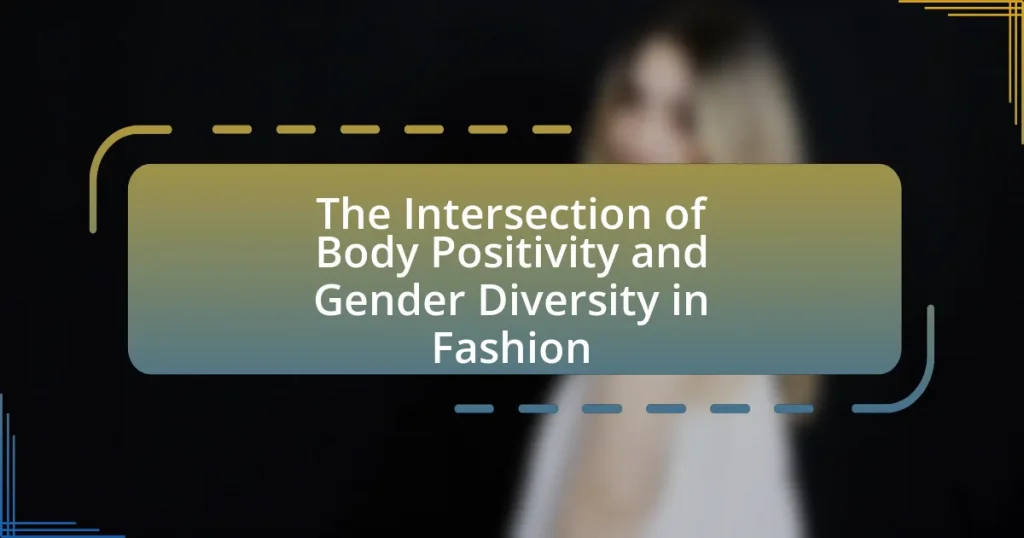The article explores the intersection of body positivity and gender diversity in the fashion industry, emphasizing the movement towards inclusivity that embraces diverse body shapes, sizes, and gender identities. It highlights how brands like Savage X Fenty and Aerie have successfully integrated these values into their marketing strategies, enhancing representation and fostering acceptance. The discussion includes the historical roots of body positivity, the evolution of gender diversity, and the challenges faced by marginalized bodies in fashion. Additionally, it examines the impact of these movements on consumer behavior, brand identity, and future trends, while offering practical steps for consumers to support inclusivity in the industry.

What is the Intersection of Body Positivity and Gender Diversity in Fashion?
The intersection of body positivity and gender diversity in fashion is characterized by the movement towards inclusivity that embraces diverse body shapes, sizes, and gender identities. This intersection promotes the idea that fashion should cater to all individuals, regardless of their body type or gender expression, challenging traditional beauty standards and norms. For instance, brands like Savage X Fenty and Aerie have successfully integrated body positivity by featuring models of various sizes and gender identities in their campaigns, thereby validating the experiences of marginalized groups. This approach not only enhances representation but also fosters a more accepting and diverse fashion industry, as evidenced by the increasing demand for gender-neutral clothing lines and the rise of body-positive influencers who advocate for change.
How do body positivity and gender diversity manifest in the fashion industry?
Body positivity and gender diversity manifest in the fashion industry through inclusive sizing, diverse representation in advertising, and the promotion of non-binary and gender-fluid clothing lines. Major brands like Aerie and Savage X Fenty have embraced body positivity by featuring models of various sizes and shapes, which has led to increased consumer engagement and sales. Additionally, the rise of gender-neutral collections from designers such as Telfar and Palomo Spain reflects a shift towards recognizing and celebrating gender diversity, allowing individuals to express their identities beyond traditional gender norms. This movement is supported by research indicating that 67% of consumers prefer brands that promote body positivity and inclusivity, highlighting the industry’s response to societal demands for representation and acceptance.
What are the historical roots of body positivity in fashion?
The historical roots of body positivity in fashion can be traced back to the 1960s and 1970s, when the feminist movement began challenging traditional beauty standards. Activists advocated for the acceptance of diverse body types, leading to the emergence of plus-size models and clothing lines. This shift was further influenced by the 1990s’ “Real Beauty” campaign by Dove, which celebrated natural beauty and aimed to redefine societal norms. These movements collectively laid the groundwork for the contemporary body positivity movement, which emphasizes self-acceptance and inclusivity in fashion.
How has gender diversity evolved within the fashion sector?
Gender diversity within the fashion sector has significantly evolved over the past few decades, moving from a predominantly male-dominated industry to one that increasingly embraces a broader spectrum of gender identities. Historically, the fashion industry was largely controlled by male designers and executives, but recent years have seen a rise in female leadership and representation, with women now holding key positions in major fashion houses and brands. For instance, as of 2021, women accounted for approximately 60% of the workforce in the fashion industry, according to the Council of Fashion Designers of America. Additionally, the push for inclusivity has led to greater visibility for non-binary and transgender individuals, with brands like Gucci and Balenciaga featuring gender-fluid models in their campaigns. This shift reflects a growing recognition of the importance of diverse gender representation, aligning with broader societal movements advocating for equality and acceptance across all gender identities.
Why is the intersection of body positivity and gender diversity important?
The intersection of body positivity and gender diversity is important because it promotes inclusivity and challenges societal norms regarding beauty and identity. This intersection allows individuals of all body types and gender identities to feel represented and accepted, fostering a culture that values diversity. Research indicates that inclusive representation in media and fashion can significantly improve self-esteem and body image among marginalized groups, as seen in studies by the American Psychological Association, which highlight the positive effects of representation on mental health. By embracing both body positivity and gender diversity, the fashion industry can contribute to a more equitable society that recognizes and celebrates the uniqueness of every individual.
What impact does this intersection have on consumer behavior?
The intersection of body positivity and gender diversity in fashion significantly influences consumer behavior by promoting inclusivity and encouraging diverse representation in marketing. This shift leads consumers to favor brands that align with their values of acceptance and diversity, resulting in increased brand loyalty and purchasing intent. Research indicates that 67% of consumers are more likely to buy from brands that showcase diverse body types and gender identities in their advertising, highlighting the importance of representation in driving consumer choices.
How does it influence brand identity and marketing strategies?
Body positivity and gender diversity significantly influence brand identity and marketing strategies by promoting inclusivity and authenticity. Brands that embrace these values often see enhanced customer loyalty and engagement, as consumers increasingly prefer companies that reflect diverse body types and gender identities. For instance, a study by the American Psychological Association found that inclusive marketing can lead to a 20% increase in brand loyalty among consumers who identify with the represented groups. This shift in focus not only strengthens brand identity but also aligns marketing strategies with contemporary social values, making brands more relatable and appealing to a broader audience.
What challenges exist at the intersection of body positivity and gender diversity in fashion?
The challenges at the intersection of body positivity and gender diversity in fashion include the limited representation of diverse body types and gender identities in mainstream fashion. This lack of representation often leads to the perpetuation of narrow beauty standards that exclude non-binary and gender-nonconforming individuals, as well as those with larger body sizes. For instance, a study by the University of Southern California found that only 2% of models in major fashion campaigns represented plus-size individuals, while gender diversity remains underrepresented, with many brands still primarily showcasing cisgender models. This creates an environment where individuals who do not conform to traditional gender norms or body types feel marginalized and unsupported, hindering the overall movement towards inclusivity in the fashion industry.
What barriers do marginalized bodies face in the fashion industry?
Marginalized bodies face significant barriers in the fashion industry, including limited representation, discriminatory sizing, and lack of inclusivity in marketing. These barriers manifest as a lack of diverse models in advertising campaigns, which perpetuates narrow beauty standards. For instance, a study by the University of Southern California found that only 2.4% of models in fashion magazines represented plus-size bodies, highlighting the industry’s failure to embrace body diversity. Additionally, many clothing brands do not offer extended sizing, which excludes individuals who do not fit conventional body types. This exclusion not only affects consumer access but also reinforces societal stigmas around body image. Furthermore, marginalized groups, including people of color and those with disabilities, often encounter additional challenges, such as cultural appropriation and inadequate accessibility in fashion spaces. These systemic issues contribute to a fashion landscape that frequently overlooks the needs and identities of marginalized bodies.
How do societal norms affect the representation of diverse bodies?
Societal norms significantly influence the representation of diverse bodies by establishing standards of beauty and acceptability that often marginalize non-conforming body types. These norms dictate what is considered attractive, leading to underrepresentation of various body shapes, sizes, and identities in media and fashion. For instance, a study by the American Psychological Association found that exposure to idealized body images can negatively impact self-esteem and body image among individuals who do not fit these ideals. Furthermore, the fashion industry has historically prioritized thinness and Eurocentric features, which perpetuates stereotypes and limits visibility for diverse bodies. This lack of representation can reinforce societal biases and hinder the acceptance of body diversity, as seen in campaigns that challenge these norms, such as Aerie’s #AerieREAL, which promotes body positivity and inclusivity.
How can the fashion industry promote inclusivity?
The fashion industry can promote inclusivity by diversifying its representation in marketing, design, and production processes. This includes featuring models of various body types, ethnicities, and gender identities in campaigns and runway shows, which has been shown to resonate with a broader audience and increase brand loyalty. For instance, a study by the University of Kent found that brands showcasing diverse models experienced a 30% increase in consumer engagement. Additionally, implementing size-inclusive clothing lines and ensuring accessibility in fashion retail can further enhance inclusivity, as evidenced by the growing demand for plus-size fashion, which has seen a market growth of 17% from 2019 to 2021.
What role do designers play in fostering body positivity and gender diversity?
Designers play a crucial role in fostering body positivity and gender diversity by creating inclusive fashion that represents a wide range of body types and gender identities. By prioritizing diverse models in campaigns and designing clothing that accommodates various shapes and sizes, designers challenge traditional beauty standards and promote acceptance. For instance, brands like Savage X Fenty have been recognized for their commitment to inclusivity, showcasing models of different sizes and ethnicities, which has positively influenced public perception and encouraged other designers to adopt similar practices. This shift not only empowers individuals to embrace their bodies but also contributes to a broader cultural movement advocating for diversity and acceptance in the fashion industry.
How can brands implement more inclusive sizing and representation?
Brands can implement more inclusive sizing and representation by expanding their size ranges to accommodate diverse body types and actively featuring models of various sizes, genders, and ethnicities in their marketing campaigns. Research indicates that 67% of consumers prefer brands that offer a wider range of sizes, highlighting the demand for inclusivity in fashion. Additionally, brands can engage in community feedback to understand the needs of their audience better, ensuring that their offerings reflect real-world diversity. By adopting these practices, brands not only enhance their market reach but also foster a more inclusive environment that resonates with a broader customer base.
What are the future trends in body positivity and gender diversity in fashion?
Future trends in body positivity and gender diversity in fashion include increased representation of diverse body types and gender identities in marketing and runway shows. Brands are shifting towards inclusive sizing and gender-neutral clothing lines, reflecting a growing consumer demand for authenticity and diversity. Research by the Fashion Institute of Technology indicates that 67% of consumers prefer brands that promote body positivity, while a report from McKinsey highlights that gender-diverse brands see a 30% increase in customer loyalty. This trend is further supported by social media movements advocating for inclusivity, driving brands to adopt more progressive practices.
How are emerging designers challenging traditional fashion norms?
Emerging designers are challenging traditional fashion norms by prioritizing inclusivity and diversity in their collections. They are redefining beauty standards by creating clothing that caters to a wide range of body types and gender identities, moving away from the conventional sizing and gender binaries that have dominated the industry. For instance, designers like Palomo Spain and Telfar have gained recognition for their gender-fluid designs, which promote a more expansive view of fashion that embraces all identities. This shift is supported by the growing demand for body positivity, as evidenced by the rise of brands that feature models of various sizes and backgrounds in their campaigns, reflecting a broader societal movement towards acceptance and representation.
What innovations are being introduced to support inclusivity in fashion?
Innovations supporting inclusivity in fashion include adaptive clothing designs, size diversity in collections, and the use of technology for personalized fit. Adaptive clothing caters to individuals with disabilities by incorporating features like magnetic closures and adjustable fits, making garments easier to wear. Size diversity is increasingly recognized, with brands expanding their size ranges to include plus-size and petite options, reflecting a broader spectrum of body types. Additionally, technology such as 3D body scanning and virtual fitting rooms allows consumers to find personalized fits, enhancing accessibility and comfort. These innovations collectively aim to create a more inclusive fashion landscape that embraces body positivity and gender diversity.
What practical steps can consumers take to support body positivity and gender diversity in fashion?
Consumers can support body positivity and gender diversity in fashion by choosing to purchase from brands that prioritize inclusivity and diverse representation. By actively seeking out companies that showcase models of various body types and gender identities in their marketing and product offerings, consumers can help shift industry standards. Research indicates that brands with diverse representation not only foster a more inclusive environment but also see increased customer loyalty and sales, as 67% of consumers prefer brands that reflect their values. Additionally, consumers can advocate for change by voicing their support on social media, participating in campaigns that promote body positivity, and providing feedback to brands about their representation practices. This collective action can influence brands to adopt more inclusive policies and practices, ultimately contributing to a more diverse and accepting fashion industry.














